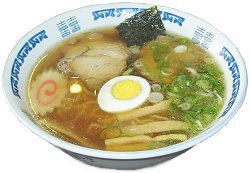 Gyudon (beef bowl) is a popular domburi dish consisting of beef and onion served over a bowl of rice. The meat and onion are cooked in a mixture of soy sauce, mirin, sugar and sake giving the dish a sweet, salty flavour. Many chain restaurants (gyudon-ya) specialize in gyudon making it an informal, inexpensive dining option frequented by students, and ideally suited to travelers on a budget.
Gyudon (beef bowl) is a popular domburi dish consisting of beef and onion served over a bowl of rice. The meat and onion are cooked in a mixture of soy sauce, mirin, sugar and sake giving the dish a sweet, salty flavour. Many chain restaurants (gyudon-ya) specialize in gyudon making it an informal, inexpensive dining option frequented by students, and ideally suited to travelers on a budget.Typically, beni shoga (pickled red ginger) and shichimi (red chili mix) are available at the table and added to taste. Tofu or konnyaku (devil`s tongue) may be cooked along with the beef although these ingredients are more common in home recipes than at restaurants. Common restaurant additions are a beaten raw egg stirred into the finished product, or green onions sprinkled on top of the meat.
 Between 2004 and 2006, a Japanese ban on imported American beef drastically affected the production and sale of gyudon, causing upset among gyudon lovers. However, the ban increased the popularity and frequency of butadon and tondon, which are both pork variations of beef bowl.
Between 2004 and 2006, a Japanese ban on imported American beef drastically affected the production and sale of gyudon, causing upset among gyudon lovers. However, the ban increased the popularity and frequency of butadon and tondon, which are both pork variations of beef bowl.Gyudon ya are numerous and often open 24 hours. These restaurants operate in one of two ways. Either a staff member takes one's order as usual, or the meal is paid for in advance at a vending machine located near the restaurant entrance.
A side bowl of miso soup may come with the meal or be offered in a combo set. Other side dishes are salad and kimchi. Tea and water are offered for free with refill jugs available on the table for customers to serve themselves.










